Definition of Leadership and Patients Safety
VerifiedAdded on 2022/09/14
|8
|2246
|13
AI Summary
Contribute Materials
Your contribution can guide someone’s learning journey. Share your
documents today.

1
Title
Student’s name
Student’s id
Title
Student’s name
Student’s id
Secure Best Marks with AI Grader
Need help grading? Try our AI Grader for instant feedback on your assignments.
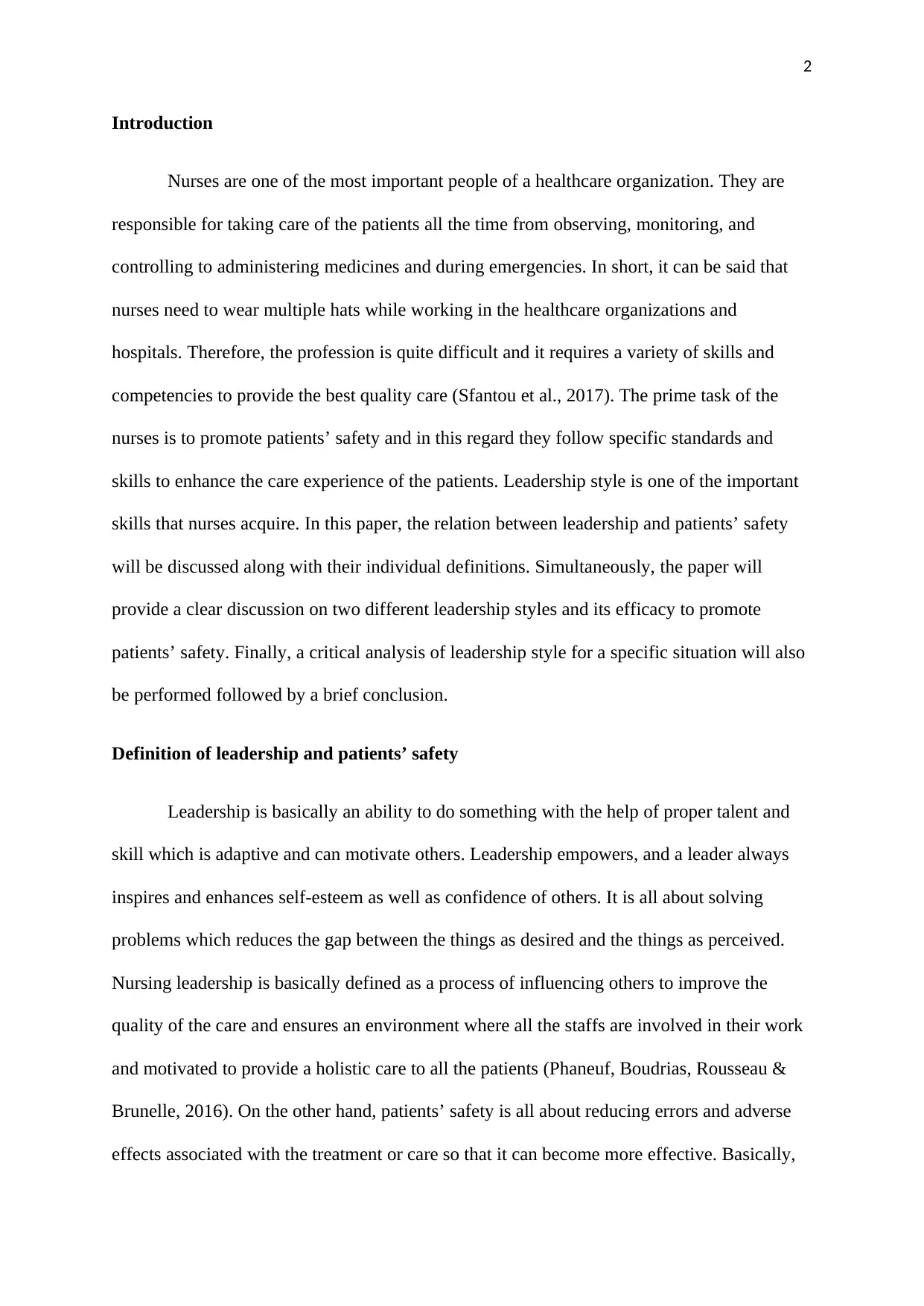
2
Introduction
Nurses are one of the most important people of a healthcare organization. They are
responsible for taking care of the patients all the time from observing, monitoring, and
controlling to administering medicines and during emergencies. In short, it can be said that
nurses need to wear multiple hats while working in the healthcare organizations and
hospitals. Therefore, the profession is quite difficult and it requires a variety of skills and
competencies to provide the best quality care (Sfantou et al., 2017). The prime task of the
nurses is to promote patients’ safety and in this regard they follow specific standards and
skills to enhance the care experience of the patients. Leadership style is one of the important
skills that nurses acquire. In this paper, the relation between leadership and patients’ safety
will be discussed along with their individual definitions. Simultaneously, the paper will
provide a clear discussion on two different leadership styles and its efficacy to promote
patients’ safety. Finally, a critical analysis of leadership style for a specific situation will also
be performed followed by a brief conclusion.
Definition of leadership and patients’ safety
Leadership is basically an ability to do something with the help of proper talent and
skill which is adaptive and can motivate others. Leadership empowers, and a leader always
inspires and enhances self-esteem as well as confidence of others. It is all about solving
problems which reduces the gap between the things as desired and the things as perceived.
Nursing leadership is basically defined as a process of influencing others to improve the
quality of the care and ensures an environment where all the staffs are involved in their work
and motivated to provide a holistic care to all the patients (Phaneuf, Boudrias, Rousseau &
Brunelle, 2016). On the other hand, patients’ safety is all about reducing errors and adverse
effects associated with the treatment or care so that it can become more effective. Basically,
Introduction
Nurses are one of the most important people of a healthcare organization. They are
responsible for taking care of the patients all the time from observing, monitoring, and
controlling to administering medicines and during emergencies. In short, it can be said that
nurses need to wear multiple hats while working in the healthcare organizations and
hospitals. Therefore, the profession is quite difficult and it requires a variety of skills and
competencies to provide the best quality care (Sfantou et al., 2017). The prime task of the
nurses is to promote patients’ safety and in this regard they follow specific standards and
skills to enhance the care experience of the patients. Leadership style is one of the important
skills that nurses acquire. In this paper, the relation between leadership and patients’ safety
will be discussed along with their individual definitions. Simultaneously, the paper will
provide a clear discussion on two different leadership styles and its efficacy to promote
patients’ safety. Finally, a critical analysis of leadership style for a specific situation will also
be performed followed by a brief conclusion.
Definition of leadership and patients’ safety
Leadership is basically an ability to do something with the help of proper talent and
skill which is adaptive and can motivate others. Leadership empowers, and a leader always
inspires and enhances self-esteem as well as confidence of others. It is all about solving
problems which reduces the gap between the things as desired and the things as perceived.
Nursing leadership is basically defined as a process of influencing others to improve the
quality of the care and ensures an environment where all the staffs are involved in their work
and motivated to provide a holistic care to all the patients (Phaneuf, Boudrias, Rousseau &
Brunelle, 2016). On the other hand, patients’ safety is all about reducing errors and adverse
effects associated with the treatment or care so that it can become more effective. Basically,
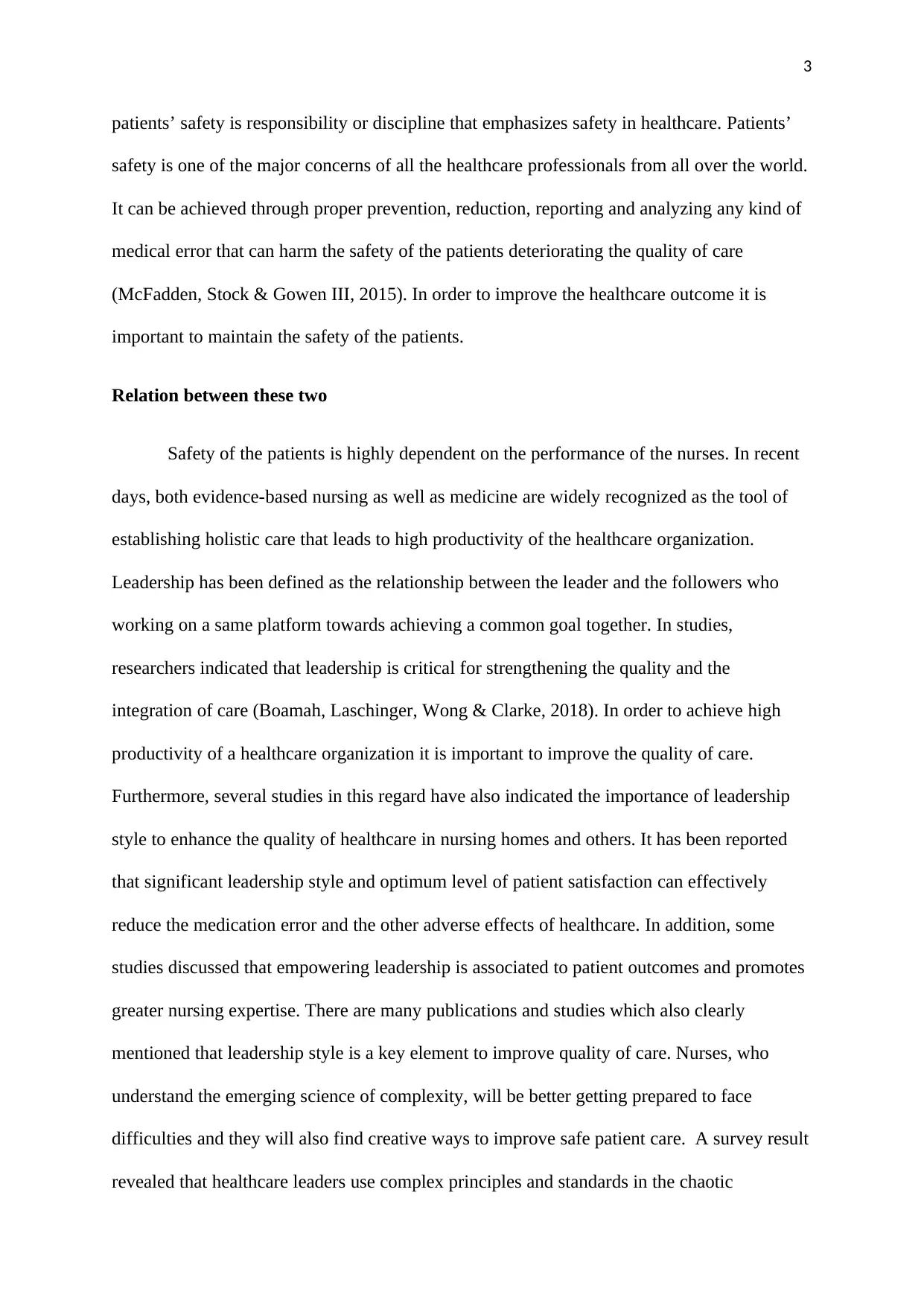
3
patients’ safety is responsibility or discipline that emphasizes safety in healthcare. Patients’
safety is one of the major concerns of all the healthcare professionals from all over the world.
It can be achieved through proper prevention, reduction, reporting and analyzing any kind of
medical error that can harm the safety of the patients deteriorating the quality of care
(McFadden, Stock & Gowen III, 2015). In order to improve the healthcare outcome it is
important to maintain the safety of the patients.
Relation between these two
Safety of the patients is highly dependent on the performance of the nurses. In recent
days, both evidence-based nursing as well as medicine are widely recognized as the tool of
establishing holistic care that leads to high productivity of the healthcare organization.
Leadership has been defined as the relationship between the leader and the followers who
working on a same platform towards achieving a common goal together. In studies,
researchers indicated that leadership is critical for strengthening the quality and the
integration of care (Boamah, Laschinger, Wong & Clarke, 2018). In order to achieve high
productivity of a healthcare organization it is important to improve the quality of care.
Furthermore, several studies in this regard have also indicated the importance of leadership
style to enhance the quality of healthcare in nursing homes and others. It has been reported
that significant leadership style and optimum level of patient satisfaction can effectively
reduce the medication error and the other adverse effects of healthcare. In addition, some
studies discussed that empowering leadership is associated to patient outcomes and promotes
greater nursing expertise. There are many publications and studies which also clearly
mentioned that leadership style is a key element to improve quality of care. Nurses, who
understand the emerging science of complexity, will be better getting prepared to face
difficulties and they will also find creative ways to improve safe patient care. A survey result
revealed that healthcare leaders use complex principles and standards in the chaotic
patients’ safety is responsibility or discipline that emphasizes safety in healthcare. Patients’
safety is one of the major concerns of all the healthcare professionals from all over the world.
It can be achieved through proper prevention, reduction, reporting and analyzing any kind of
medical error that can harm the safety of the patients deteriorating the quality of care
(McFadden, Stock & Gowen III, 2015). In order to improve the healthcare outcome it is
important to maintain the safety of the patients.
Relation between these two
Safety of the patients is highly dependent on the performance of the nurses. In recent
days, both evidence-based nursing as well as medicine are widely recognized as the tool of
establishing holistic care that leads to high productivity of the healthcare organization.
Leadership has been defined as the relationship between the leader and the followers who
working on a same platform towards achieving a common goal together. In studies,
researchers indicated that leadership is critical for strengthening the quality and the
integration of care (Boamah, Laschinger, Wong & Clarke, 2018). In order to achieve high
productivity of a healthcare organization it is important to improve the quality of care.
Furthermore, several studies in this regard have also indicated the importance of leadership
style to enhance the quality of healthcare in nursing homes and others. It has been reported
that significant leadership style and optimum level of patient satisfaction can effectively
reduce the medication error and the other adverse effects of healthcare. In addition, some
studies discussed that empowering leadership is associated to patient outcomes and promotes
greater nursing expertise. There are many publications and studies which also clearly
mentioned that leadership style is a key element to improve quality of care. Nurses, who
understand the emerging science of complexity, will be better getting prepared to face
difficulties and they will also find creative ways to improve safe patient care. A survey result
revealed that healthcare leaders use complex principles and standards in the chaotic
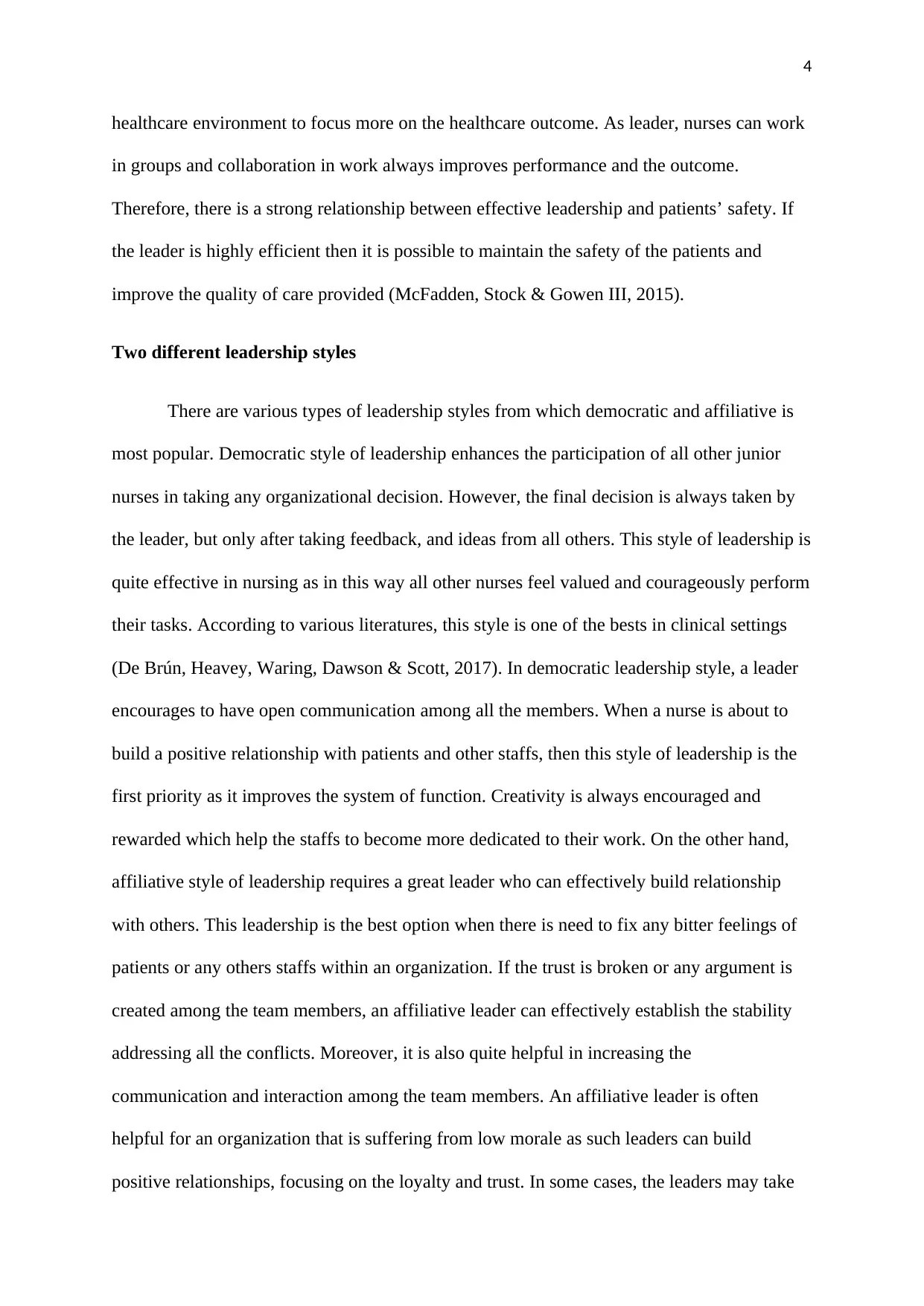
4
healthcare environment to focus more on the healthcare outcome. As leader, nurses can work
in groups and collaboration in work always improves performance and the outcome.
Therefore, there is a strong relationship between effective leadership and patients’ safety. If
the leader is highly efficient then it is possible to maintain the safety of the patients and
improve the quality of care provided (McFadden, Stock & Gowen III, 2015).
Two different leadership styles
There are various types of leadership styles from which democratic and affiliative is
most popular. Democratic style of leadership enhances the participation of all other junior
nurses in taking any organizational decision. However, the final decision is always taken by
the leader, but only after taking feedback, and ideas from all others. This style of leadership is
quite effective in nursing as in this way all other nurses feel valued and courageously perform
their tasks. According to various literatures, this style is one of the bests in clinical settings
(De Brún, Heavey, Waring, Dawson & Scott, 2017). In democratic leadership style, a leader
encourages to have open communication among all the members. When a nurse is about to
build a positive relationship with patients and other staffs, then this style of leadership is the
first priority as it improves the system of function. Creativity is always encouraged and
rewarded which help the staffs to become more dedicated to their work. On the other hand,
affiliative style of leadership requires a great leader who can effectively build relationship
with others. This leadership is the best option when there is need to fix any bitter feelings of
patients or any others staffs within an organization. If the trust is broken or any argument is
created among the team members, an affiliative leader can effectively establish the stability
addressing all the conflicts. Moreover, it is also quite helpful in increasing the
communication and interaction among the team members. An affiliative leader is often
helpful for an organization that is suffering from low morale as such leaders can build
positive relationships, focusing on the loyalty and trust. In some cases, the leaders may take
healthcare environment to focus more on the healthcare outcome. As leader, nurses can work
in groups and collaboration in work always improves performance and the outcome.
Therefore, there is a strong relationship between effective leadership and patients’ safety. If
the leader is highly efficient then it is possible to maintain the safety of the patients and
improve the quality of care provided (McFadden, Stock & Gowen III, 2015).
Two different leadership styles
There are various types of leadership styles from which democratic and affiliative is
most popular. Democratic style of leadership enhances the participation of all other junior
nurses in taking any organizational decision. However, the final decision is always taken by
the leader, but only after taking feedback, and ideas from all others. This style of leadership is
quite effective in nursing as in this way all other nurses feel valued and courageously perform
their tasks. According to various literatures, this style is one of the bests in clinical settings
(De Brún, Heavey, Waring, Dawson & Scott, 2017). In democratic leadership style, a leader
encourages to have open communication among all the members. When a nurse is about to
build a positive relationship with patients and other staffs, then this style of leadership is the
first priority as it improves the system of function. Creativity is always encouraged and
rewarded which help the staffs to become more dedicated to their work. On the other hand,
affiliative style of leadership requires a great leader who can effectively build relationship
with others. This leadership is the best option when there is need to fix any bitter feelings of
patients or any others staffs within an organization. If the trust is broken or any argument is
created among the team members, an affiliative leader can effectively establish the stability
addressing all the conflicts. Moreover, it is also quite helpful in increasing the
communication and interaction among the team members. An affiliative leader is often
helpful for an organization that is suffering from low morale as such leaders can build
positive relationships, focusing on the loyalty and trust. In some cases, the leaders may take
Secure Best Marks with AI Grader
Need help grading? Try our AI Grader for instant feedback on your assignments.
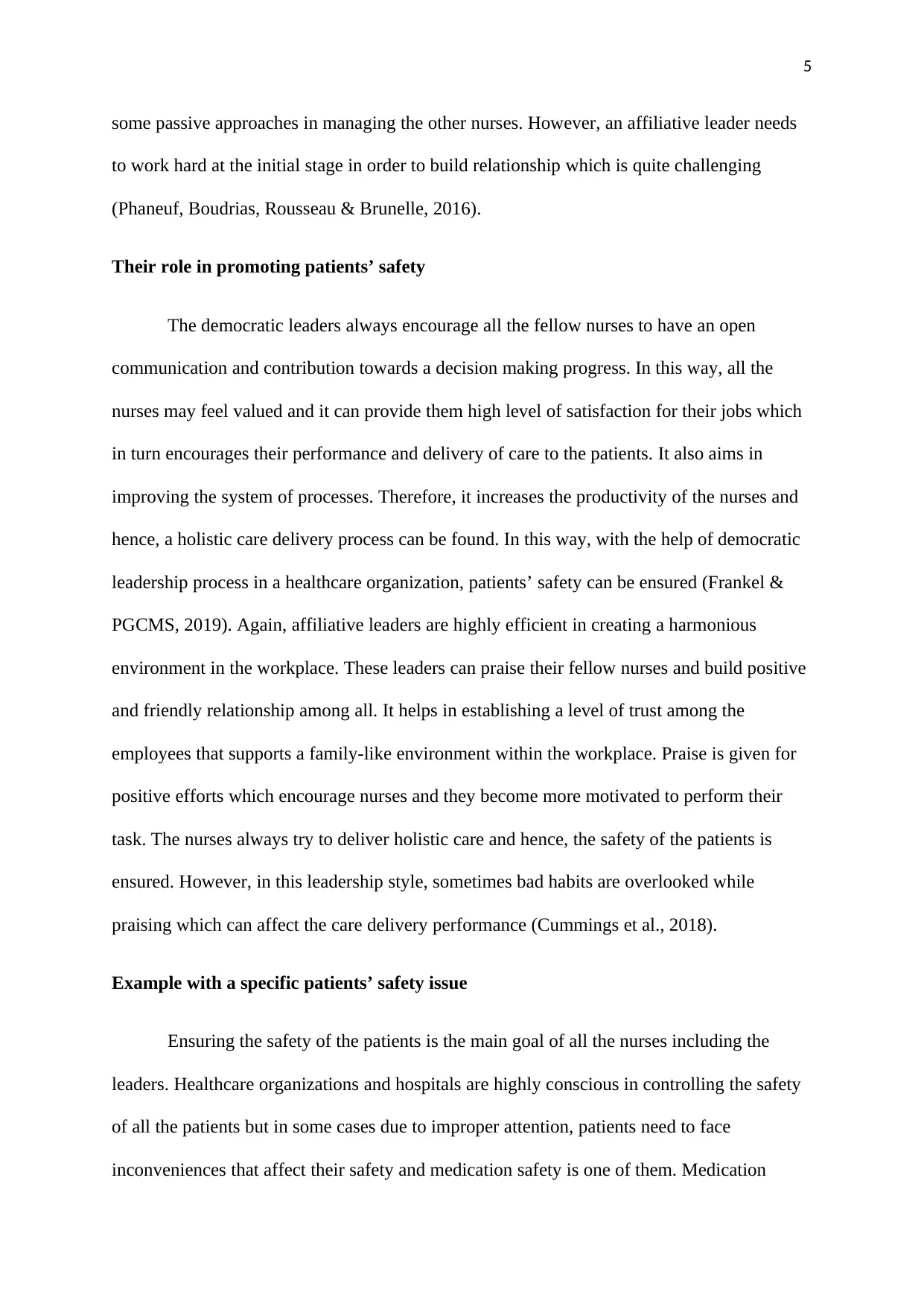
5
some passive approaches in managing the other nurses. However, an affiliative leader needs
to work hard at the initial stage in order to build relationship which is quite challenging
(Phaneuf, Boudrias, Rousseau & Brunelle, 2016).
Their role in promoting patients’ safety
The democratic leaders always encourage all the fellow nurses to have an open
communication and contribution towards a decision making progress. In this way, all the
nurses may feel valued and it can provide them high level of satisfaction for their jobs which
in turn encourages their performance and delivery of care to the patients. It also aims in
improving the system of processes. Therefore, it increases the productivity of the nurses and
hence, a holistic care delivery process can be found. In this way, with the help of democratic
leadership process in a healthcare organization, patients’ safety can be ensured (Frankel &
PGCMS, 2019). Again, affiliative leaders are highly efficient in creating a harmonious
environment in the workplace. These leaders can praise their fellow nurses and build positive
and friendly relationship among all. It helps in establishing a level of trust among the
employees that supports a family-like environment within the workplace. Praise is given for
positive efforts which encourage nurses and they become more motivated to perform their
task. The nurses always try to deliver holistic care and hence, the safety of the patients is
ensured. However, in this leadership style, sometimes bad habits are overlooked while
praising which can affect the care delivery performance (Cummings et al., 2018).
Example with a specific patients’ safety issue
Ensuring the safety of the patients is the main goal of all the nurses including the
leaders. Healthcare organizations and hospitals are highly conscious in controlling the safety
of all the patients but in some cases due to improper attention, patients need to face
inconveniences that affect their safety and medication safety is one of them. Medication
some passive approaches in managing the other nurses. However, an affiliative leader needs
to work hard at the initial stage in order to build relationship which is quite challenging
(Phaneuf, Boudrias, Rousseau & Brunelle, 2016).
Their role in promoting patients’ safety
The democratic leaders always encourage all the fellow nurses to have an open
communication and contribution towards a decision making progress. In this way, all the
nurses may feel valued and it can provide them high level of satisfaction for their jobs which
in turn encourages their performance and delivery of care to the patients. It also aims in
improving the system of processes. Therefore, it increases the productivity of the nurses and
hence, a holistic care delivery process can be found. In this way, with the help of democratic
leadership process in a healthcare organization, patients’ safety can be ensured (Frankel &
PGCMS, 2019). Again, affiliative leaders are highly efficient in creating a harmonious
environment in the workplace. These leaders can praise their fellow nurses and build positive
and friendly relationship among all. It helps in establishing a level of trust among the
employees that supports a family-like environment within the workplace. Praise is given for
positive efforts which encourage nurses and they become more motivated to perform their
task. The nurses always try to deliver holistic care and hence, the safety of the patients is
ensured. However, in this leadership style, sometimes bad habits are overlooked while
praising which can affect the care delivery performance (Cummings et al., 2018).
Example with a specific patients’ safety issue
Ensuring the safety of the patients is the main goal of all the nurses including the
leaders. Healthcare organizations and hospitals are highly conscious in controlling the safety
of all the patients but in some cases due to improper attention, patients need to face
inconveniences that affect their safety and medication safety is one of them. Medication
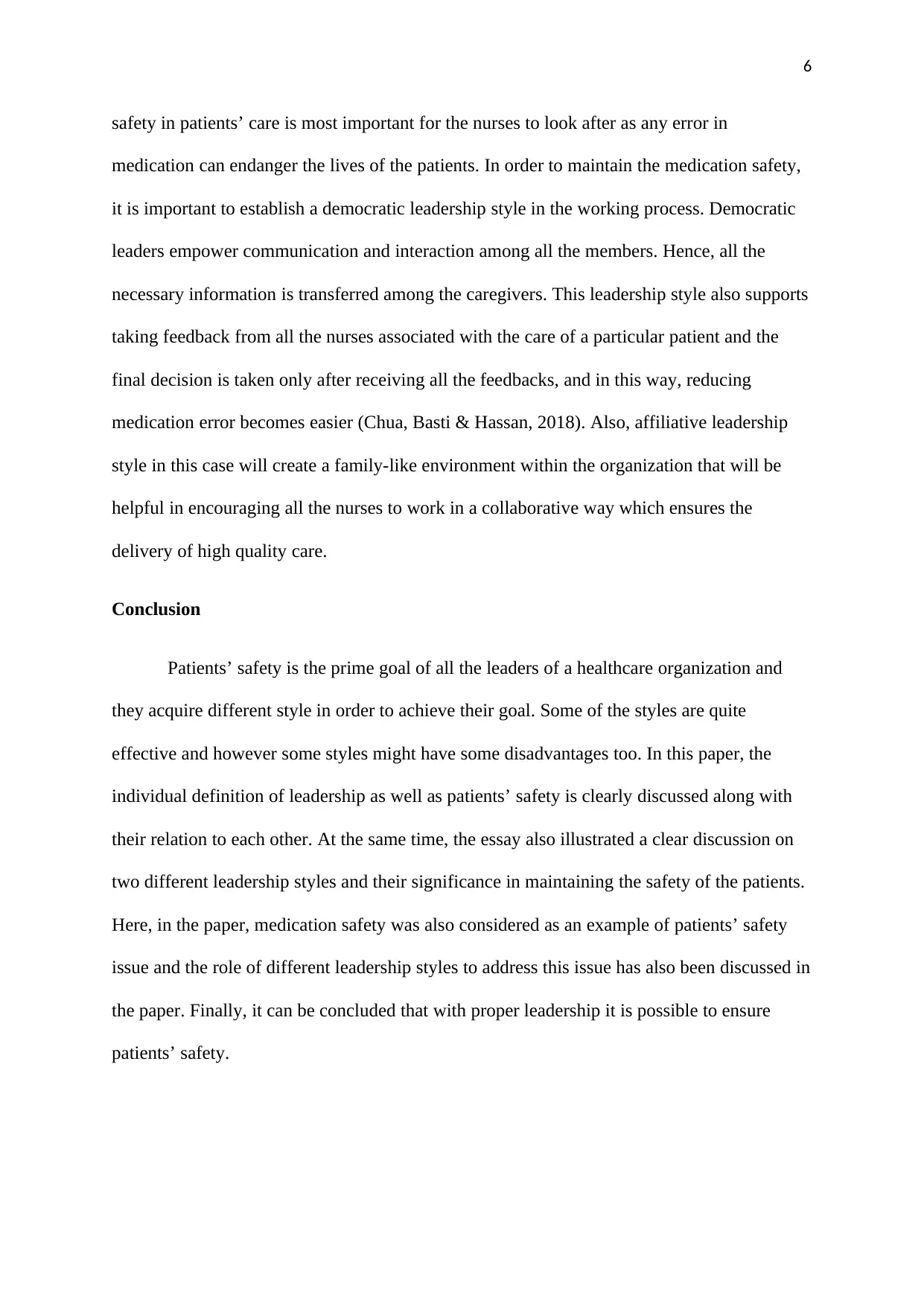
6
safety in patients’ care is most important for the nurses to look after as any error in
medication can endanger the lives of the patients. In order to maintain the medication safety,
it is important to establish a democratic leadership style in the working process. Democratic
leaders empower communication and interaction among all the members. Hence, all the
necessary information is transferred among the caregivers. This leadership style also supports
taking feedback from all the nurses associated with the care of a particular patient and the
final decision is taken only after receiving all the feedbacks, and in this way, reducing
medication error becomes easier (Chua, Basti & Hassan, 2018). Also, affiliative leadership
style in this case will create a family-like environment within the organization that will be
helpful in encouraging all the nurses to work in a collaborative way which ensures the
delivery of high quality care.
Conclusion
Patients’ safety is the prime goal of all the leaders of a healthcare organization and
they acquire different style in order to achieve their goal. Some of the styles are quite
effective and however some styles might have some disadvantages too. In this paper, the
individual definition of leadership as well as patients’ safety is clearly discussed along with
their relation to each other. At the same time, the essay also illustrated a clear discussion on
two different leadership styles and their significance in maintaining the safety of the patients.
Here, in the paper, medication safety was also considered as an example of patients’ safety
issue and the role of different leadership styles to address this issue has also been discussed in
the paper. Finally, it can be concluded that with proper leadership it is possible to ensure
patients’ safety.
safety in patients’ care is most important for the nurses to look after as any error in
medication can endanger the lives of the patients. In order to maintain the medication safety,
it is important to establish a democratic leadership style in the working process. Democratic
leaders empower communication and interaction among all the members. Hence, all the
necessary information is transferred among the caregivers. This leadership style also supports
taking feedback from all the nurses associated with the care of a particular patient and the
final decision is taken only after receiving all the feedbacks, and in this way, reducing
medication error becomes easier (Chua, Basti & Hassan, 2018). Also, affiliative leadership
style in this case will create a family-like environment within the organization that will be
helpful in encouraging all the nurses to work in a collaborative way which ensures the
delivery of high quality care.
Conclusion
Patients’ safety is the prime goal of all the leaders of a healthcare organization and
they acquire different style in order to achieve their goal. Some of the styles are quite
effective and however some styles might have some disadvantages too. In this paper, the
individual definition of leadership as well as patients’ safety is clearly discussed along with
their relation to each other. At the same time, the essay also illustrated a clear discussion on
two different leadership styles and their significance in maintaining the safety of the patients.
Here, in the paper, medication safety was also considered as an example of patients’ safety
issue and the role of different leadership styles to address this issue has also been discussed in
the paper. Finally, it can be concluded that with proper leadership it is possible to ensure
patients’ safety.
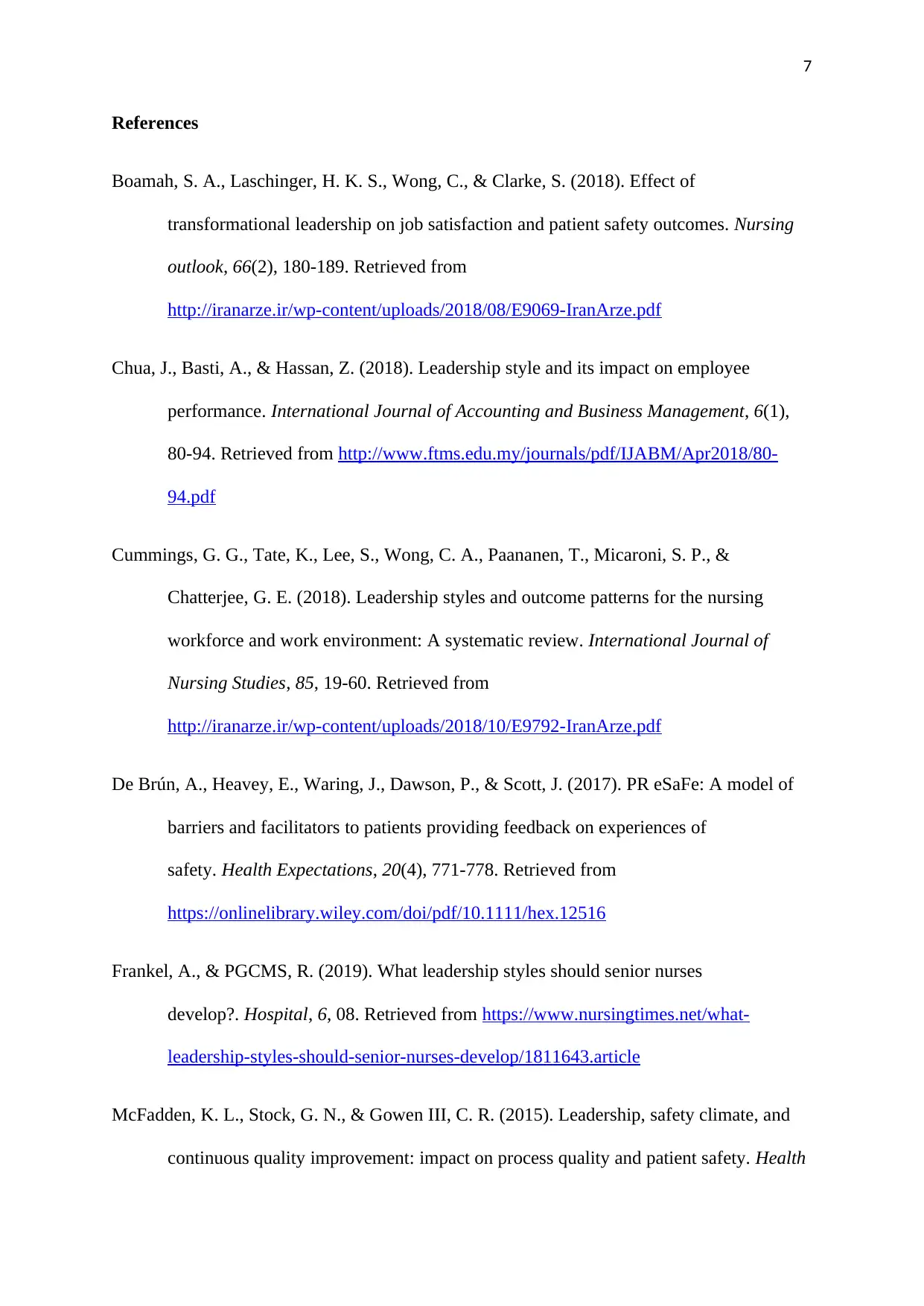
7
References
Boamah, S. A., Laschinger, H. K. S., Wong, C., & Clarke, S. (2018). Effect of
transformational leadership on job satisfaction and patient safety outcomes. Nursing
outlook, 66(2), 180-189. Retrieved from
http://iranarze.ir/wp-content/uploads/2018/08/E9069-IranArze.pdf
Chua, J., Basti, A., & Hassan, Z. (2018). Leadership style and its impact on employee
performance. International Journal of Accounting and Business Management, 6(1),
80-94. Retrieved from http://www.ftms.edu.my/journals/pdf/IJABM/Apr2018/80-
94.pdf
Cummings, G. G., Tate, K., Lee, S., Wong, C. A., Paananen, T., Micaroni, S. P., &
Chatterjee, G. E. (2018). Leadership styles and outcome patterns for the nursing
workforce and work environment: A systematic review. International Journal of
Nursing Studies, 85, 19-60. Retrieved from
http://iranarze.ir/wp-content/uploads/2018/10/E9792-IranArze.pdf
De Brún, A., Heavey, E., Waring, J., Dawson, P., & Scott, J. (2017). PR eSaFe: A model of
barriers and facilitators to patients providing feedback on experiences of
safety. Health Expectations, 20(4), 771-778. Retrieved from
https://onlinelibrary.wiley.com/doi/pdf/10.1111/hex.12516
Frankel, A., & PGCMS, R. (2019). What leadership styles should senior nurses
develop?. Hospital, 6, 08. Retrieved from https://www.nursingtimes.net/what-
leadership-styles-should-senior-nurses-develop/1811643.article
McFadden, K. L., Stock, G. N., & Gowen III, C. R. (2015). Leadership, safety climate, and
continuous quality improvement: impact on process quality and patient safety. Health
References
Boamah, S. A., Laschinger, H. K. S., Wong, C., & Clarke, S. (2018). Effect of
transformational leadership on job satisfaction and patient safety outcomes. Nursing
outlook, 66(2), 180-189. Retrieved from
http://iranarze.ir/wp-content/uploads/2018/08/E9069-IranArze.pdf
Chua, J., Basti, A., & Hassan, Z. (2018). Leadership style and its impact on employee
performance. International Journal of Accounting and Business Management, 6(1),
80-94. Retrieved from http://www.ftms.edu.my/journals/pdf/IJABM/Apr2018/80-
94.pdf
Cummings, G. G., Tate, K., Lee, S., Wong, C. A., Paananen, T., Micaroni, S. P., &
Chatterjee, G. E. (2018). Leadership styles and outcome patterns for the nursing
workforce and work environment: A systematic review. International Journal of
Nursing Studies, 85, 19-60. Retrieved from
http://iranarze.ir/wp-content/uploads/2018/10/E9792-IranArze.pdf
De Brún, A., Heavey, E., Waring, J., Dawson, P., & Scott, J. (2017). PR eSaFe: A model of
barriers and facilitators to patients providing feedback on experiences of
safety. Health Expectations, 20(4), 771-778. Retrieved from
https://onlinelibrary.wiley.com/doi/pdf/10.1111/hex.12516
Frankel, A., & PGCMS, R. (2019). What leadership styles should senior nurses
develop?. Hospital, 6, 08. Retrieved from https://www.nursingtimes.net/what-
leadership-styles-should-senior-nurses-develop/1811643.article
McFadden, K. L., Stock, G. N., & Gowen III, C. R. (2015). Leadership, safety climate, and
continuous quality improvement: impact on process quality and patient safety. Health
Paraphrase This Document
Need a fresh take? Get an instant paraphrase of this document with our AI Paraphraser
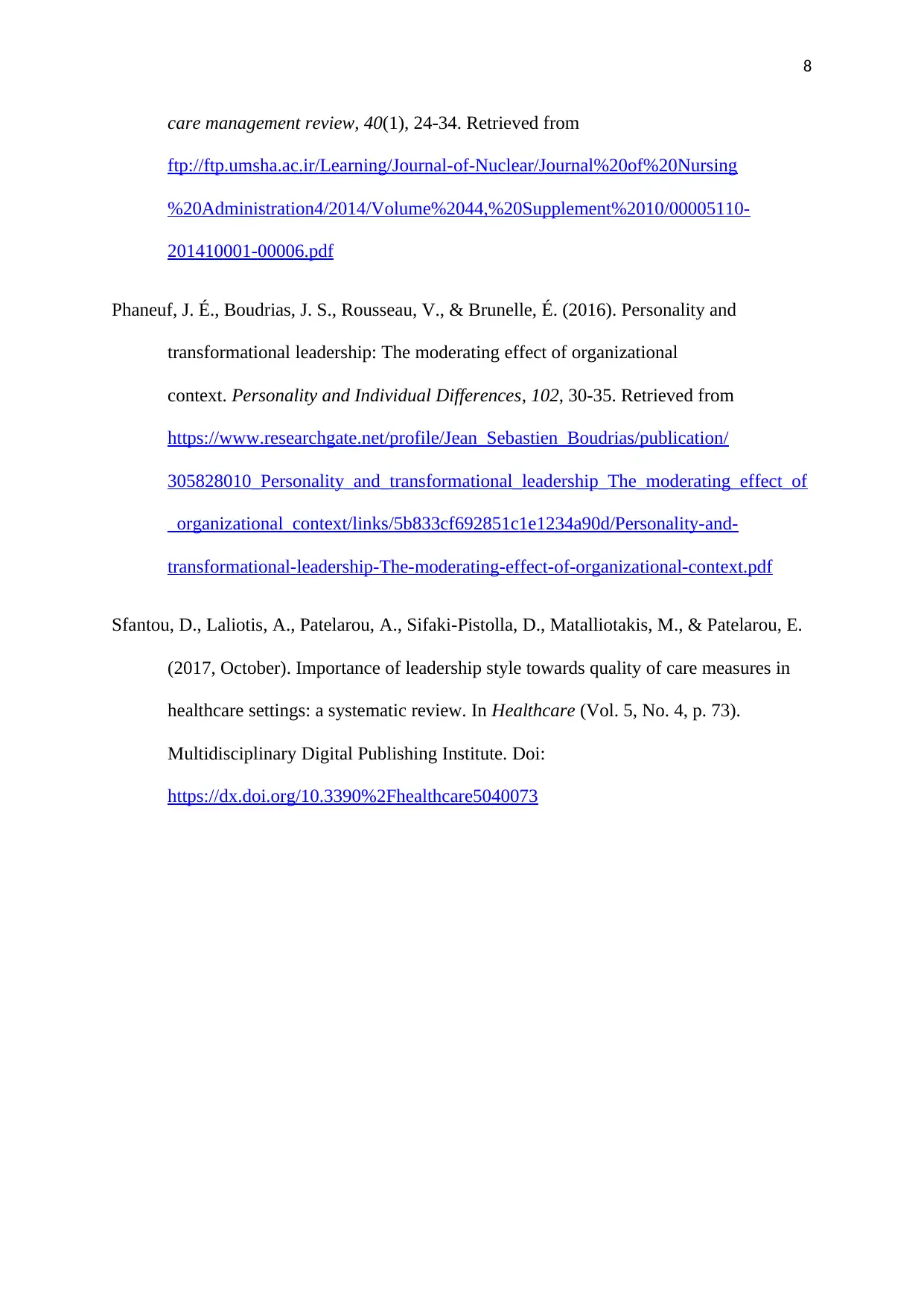
8
care management review, 40(1), 24-34. Retrieved from
ftp://ftp.umsha.ac.ir/Learning/Journal-of-Nuclear/Journal%20of%20Nursing
%20Administration4/2014/Volume%2044,%20Supplement%2010/00005110-
201410001-00006.pdf
Phaneuf, J. É., Boudrias, J. S., Rousseau, V., & Brunelle, É. (2016). Personality and
transformational leadership: The moderating effect of organizational
context. Personality and Individual Differences, 102, 30-35. Retrieved from
https://www.researchgate.net/profile/Jean_Sebastien_Boudrias/publication/
305828010_Personality_and_transformational_leadership_The_moderating_effect_of
_organizational_context/links/5b833cf692851c1e1234a90d/Personality-and-
transformational-leadership-The-moderating-effect-of-organizational-context.pdf
Sfantou, D., Laliotis, A., Patelarou, A., Sifaki-Pistolla, D., Matalliotakis, M., & Patelarou, E.
(2017, October). Importance of leadership style towards quality of care measures in
healthcare settings: a systematic review. In Healthcare (Vol. 5, No. 4, p. 73).
Multidisciplinary Digital Publishing Institute. Doi:
https://dx.doi.org/10.3390%2Fhealthcare5040073
care management review, 40(1), 24-34. Retrieved from
ftp://ftp.umsha.ac.ir/Learning/Journal-of-Nuclear/Journal%20of%20Nursing
%20Administration4/2014/Volume%2044,%20Supplement%2010/00005110-
201410001-00006.pdf
Phaneuf, J. É., Boudrias, J. S., Rousseau, V., & Brunelle, É. (2016). Personality and
transformational leadership: The moderating effect of organizational
context. Personality and Individual Differences, 102, 30-35. Retrieved from
https://www.researchgate.net/profile/Jean_Sebastien_Boudrias/publication/
305828010_Personality_and_transformational_leadership_The_moderating_effect_of
_organizational_context/links/5b833cf692851c1e1234a90d/Personality-and-
transformational-leadership-The-moderating-effect-of-organizational-context.pdf
Sfantou, D., Laliotis, A., Patelarou, A., Sifaki-Pistolla, D., Matalliotakis, M., & Patelarou, E.
(2017, October). Importance of leadership style towards quality of care measures in
healthcare settings: a systematic review. In Healthcare (Vol. 5, No. 4, p. 73).
Multidisciplinary Digital Publishing Institute. Doi:
https://dx.doi.org/10.3390%2Fhealthcare5040073
1 out of 8
Related Documents
Your All-in-One AI-Powered Toolkit for Academic Success.
+13062052269
info@desklib.com
Available 24*7 on WhatsApp / Email
![[object Object]](/_next/static/media/star-bottom.7253800d.svg)
Unlock your academic potential
© 2024 | Zucol Services PVT LTD | All rights reserved.





